EXPERT ALERT
Jeff Falk
713-348-6775
jfalk@rice.edu
Mike Williams
713-348-6728
mikewilliams@rice.edu
Rice physicist available to comment on Parker Solar Probe findings
HOUSTON – (Dec. 4, 2019) – Today, NASA will reveal the first discoveries from the Parker Solar Probe, launched in 2018 on a seven-year mission to skim the sun’s atmosphere and send back data about the solar wind.
The results will also be detailed in the journal Nature, which will publish them shortly before the teleconference at 1:30 p.m. Eastern Standard Time.
Rice solar physicist Stephen Bradshaw is available to comment on the findings. He is among many scientists whose research will benefit from data returned by the probe’s four onboard experiments.
“There are instruments onboard that measure the energy of different particles, like electrons and protons, and they will hopefully tell us the energy distributions of these particles much closer to the sun,” Bradshaw said. “That may give us some clues as to what mechanism accelerates particles in the corona, which can be related to the way the corona heats and how the solar wind is accelerated.”
Last month, NASA made scientific data gathered during the spacecraft’s first two solar orbits available to the public. The probe has completed two passes through the solar corona, using Venus as a slingshot to bring it closer to the sun with each cycle. The probe’s instruments study magnetic fields, plasma and energetic particles and image the solar wind, and are designed to withstand temperatures that reach nearly 2,500 degrees Fahrenheit.
At its closest approach, the spacecraft will travel at approximately 430,000 miles per hour, and will fly within 3.8 million miles of the sun, where the highest-energy solar particles are born.
“It’s possible that all sorts of things could come out of this announcement that will either verify and validate some of the assumptions and models that we’ve been working with for a very long time — or completely blow them up, and we’ll have to have a big rethink,” Bradshaw said. “That’s what missions like this are all about.”
The teleconference will stream live at https://www.nasa.gov/live.
To schedule an interview with Bradshaw, contact Mike Williams, senior media relations specialist at Rice, at mikewilliams@rice.edu or 713-348-6728.
Rice University has a VideoLink ReadyCam TV interview studio. ReadyCam is capable of transmitting broadcast-quality high-definition and standard-definition video directly to all news media organizations around the world 24/7. Rice also has a university backdrop, 1080p webcam, light kit and wireless mic for Skype interviews.
-30-
Follow Rice News and Media Relations via Twitter @RiceUNews.
Related materials:
Stephen Bradshaw bio: https://physics.rice.edu/people/stephen-bradshaw
Solar@Rice: http://solar.rice.edu
Wiess School of Natural Sciences: https://naturalsciences.rice.edu
Image for download:
https://news2.rice.edu/files/2019/12/1209_SOLAR-web-bradshaw.jpg
CAPTION: Stephen Bradshaw. (Credit: Jeff Fitlow/Rice University)
Located on a 300-acre forested campus in Houston, Rice University is consistently ranked among the nation’s top 20 universities by U.S. News & World Report. Rice has highly respected schools of Architecture, Business, Continuing Studies, Engineering, Humanities, Music, Natural Sciences and Social Sciences and is home to the Baker Institute for Public Policy. With 3,962 undergraduates and 3,027 graduate students, Rice’s undergraduate student-to-faculty ratio is just under 6-to-1. Its residential college system builds close-knit communities and lifelong friendships, just one reason why Rice is ranked No. 1 for lots of race/class interaction and No. 4 for quality of life by the Princeton Review. Rice is also rated as a best value among private universities by Kiplinger’s Personal Finance.


